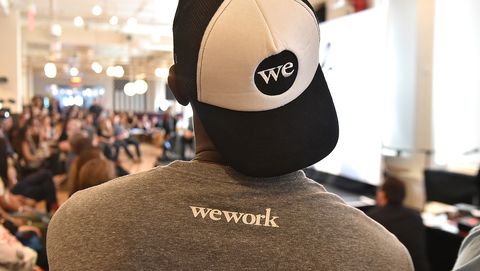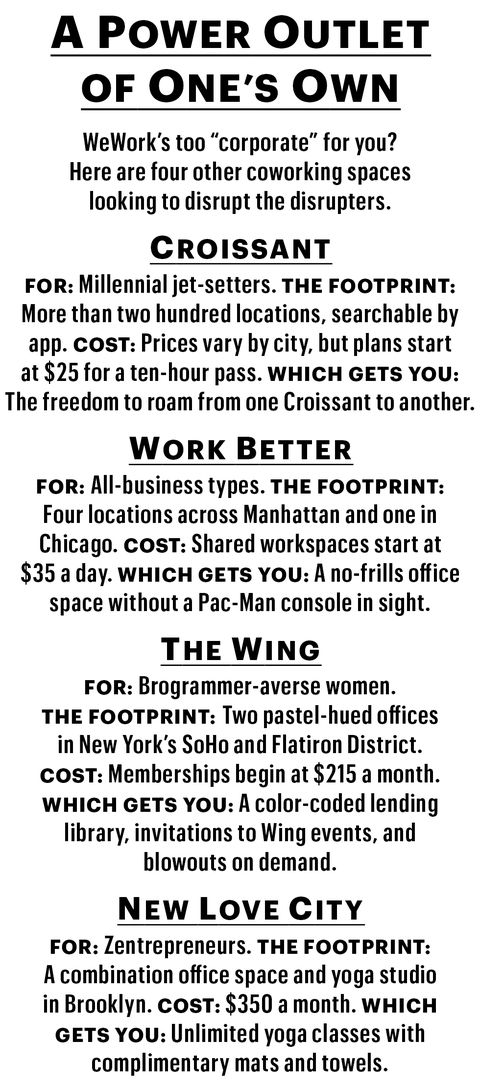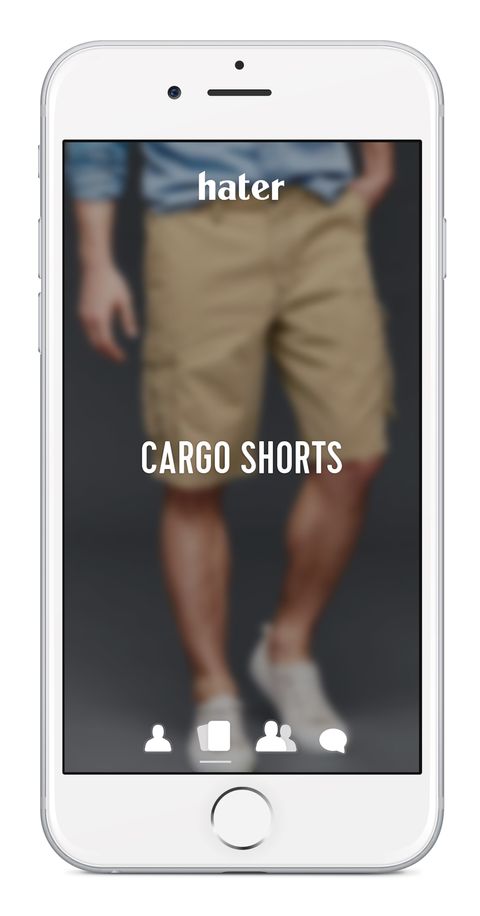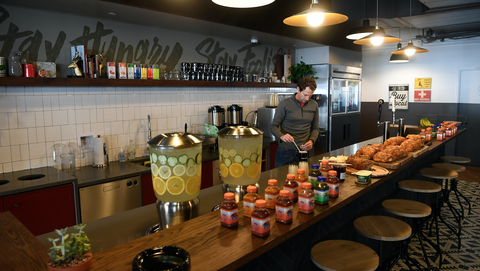Eric Konigsberg reports in Esquire:
WeWork operates in nineteen countries, with 170 locations worldwide and thirty-eight in New York alone. Fees range from $220 a month for space at a power outlet to $650 for a private office. You get unlimited coffee and craft beer, printer credits, yoga classes, themed happy hours, and lunch ’n’ learn seminars. Big companies with their own wings in WeWork: Microsoft, IBM, GE, Spotify, Bank of America, NBC. “Our valuation and size are more based on our energy and spirituality than a multiple of revenue.”
Welcome to WeWork, the eight-year-old, $20 billion “shared space” nerve center of the New New Economy—in which the corporate ladder has been replaced by a rent-a-desk, the benefits package consists of free WiFi and La Colombe, and the retirement plan is IPO or bust. But hey, at least there’s no one to boss you around anymore, right?
MONDAY MORNING.A new day, a new week, a new opportunity to master your destiny, to bite the ass off a bear, to be a coffee achiever, to hustle harder, to get shit done.Brendan Alper’s out the door by 8:41 a.m. He swipes his office key card just before 9:00 and steps onto the poured-concrete floor of the lobby, where the tableau that greets him is composed of beadboard paneling, hanging globe-shaped light fixtures, exposed pipes, a midcentury patchwork sectional sofa, banquettes for laptop rovers, a granite coffee bar (with La Colombe brew in the urns, Ronnybrook dairy products arranged neatly in a refrigerator, and bottles of sriracha sauce), a second bar with taps (Sierra Nevada, Angry Orchard), a large glass watercooler lined with grapefruit slices, an accent wall with a mural of a starry sky and mysterious hands plying a cat’s cradle, and another wall festooned with a neon word sculpture. hello brooklyn, it reads. You might recognize in these touches the zippered-hoodie aesthetics of WeWork, the company that operates the building. You might even be a WeWork tenant yourself. Perhaps you’ve taken a meeting or two in a WeWork building, or else you will soon enough, as twenty-first-century America continues its headlong shift toward the gig economy.Finally, Brendan gets to his pod-enclosed desk on the fifth floor, ready for some TCB: Taking Care of Business. Brendan is thirty and the founder of a tech company. He is bright, cheerfully handsome, well-related, well-connected, an alumnus of Brown University and Goldman Sachs, where he did operational risk management, which he concedes was “not exactly a crushing-it kind of job.” One day a couple years ago, Brendan looked at his bosses and saw his future self: “charting numbers under fluorescent light, two kids at home, counting vacation days, and at what cost?” He quit and tried writing comedy sketches but found it too solitary, plus he didn’t want to move to L.A.Last year, Brendan scraped together his life savings and started a dating app called Hater. It adds value, as the Shark Tankers say, by matching people according to their shared dislikes. He finished the beta and timed Hater’s February 2017 launch in the App Store to coincide with some canny PR stunts—coverage on The View, Good Morning America, CBS’s Sunday Morning, and Fox & Friends; features on seven blogs embargoed for the same day; a viral public- art installation depicting Trump and Putin nude and locked in an embrace. Within three weeks, he had three hundred thousand registered users worldwide. Then, per an agreement he reached with potential investors, Hater received a market valuation of $4 million, even though the company had yet to bring in a cent.Which pretty much brings us to this fine June morning. Brendan’s wearing a striped T-shirt, jeans cuffed well above the ankle, and flip-flops—an ideal uniform if you’re hanging out at your condo swimming pool all day. That’s part of the fun of being your own CEO, he says. “But there’s that existential problem I wasn’t really prepared for: Nobody’s telling me what to do. Should I be putting together a budget? Working on the design of a new app? Raising money? Trying to retain users? Trying to attract new users? Trying to build out our analytics? Should I be dressing up like a chicken and handing out business cards in Grand Army Plaza?”
There are a lot of Brendans in the Republic of WeWork, and many are right here in this corridor. Some of the outfits in the South Williamsburg, Brooklyn, location trade in worldly goods, like Conscious Step, a sock company that donates a share of its proceeds to charity; Carvana, an online used-car dealership; Motorino, a pizza micro-chain; and Visual Magnetics, which sells idea boards. Others are entirely ether-based, such as One Door, a company that offers cloud-centric “merchandising execution”; Mish Guru, a Snapchat-focused “management & analytics platform”; and DevTribe, a social-media consultancy seeking “influencers looking to increase revenue through personal branding.” There’s at least one self-employed “vlogger and design consultant,” as well as Turnkey & Bespoke, which manages retail construction projects, be they pop-up shops, promotional booths, or, yes, offices inside WeWork buildings. There’s also a company called NSFW, whose function might be described as “facilitating curated gratification.” (It puts on swingers’ parties.)Since 2010, WeWork has been leasing office space in cities—by the desk, the room, or the floor—and now operates in nineteen countries, with more than 170 locations worldwide and thirty-eight in New York alone. (In October, the company announced it was buying Lord & Taylor’s flagship building in midtown Manhattan for $850 million and moving its headquarters there.) Plenty of big companies are now tenants with their own floors or wings in WeWork: Microsoft, IBM, GE, Spotify, Bank of America, NBC Left Field, a fledgling unit of the network aimed at cord-cutting millennials. Corporations seek out WeWork “for the vibe,” according to a WeWork spokeswoman, and consider the environment “a talent- retention aspect.” In October, WeWork’s CEO, Adam Neumann, appeared on the cover of Forbes above the headline the $20 billion office party. That’s the company’s most recent valuation—about as much as the Hilton hotel empire, the story pointed out. The Wall Street Journal weighed in to ask whether that valuation is being “fueled by Silicon Valley pixie dust.” Partners including Japan’s SoftBank have lauded WeWork’s rapid growth, so far accomplished without an expensive sales department or marketing campaign. Forbes noted that among American start-ups, only Uber and Airbnb claim to be worth more, and that like both of those, “WeWork is essentially a middleman . . . an office company . . . that doesn’t own any offices.” Adam (WeWork staff and management are all first-name kinds of people) explained that he runs something much bigger. “Our valuation and size today are much more based on our energy and spirituality than it is on a multiple of revenue.”As of November, WeWork had more than 160,000 “members.” Total square footage: ten million and growing. What does WeWork’s creeping ubiquity represent? Nothing less than the transformation of modern workplace culture, according to Wired. WeWork uses office sensors to track the work habits of tenants—how many hours per day a desk sits empty, or which conference rooms tend to get the most bookings. “Soon, the company anticipates, large enterprises will outsource their office buildings to WeWork, which will draw from its increasingly sophisticated data to ensure that enterprise clients get the most productivity possible for the least amount of money,” the magazine reported.Plentyof other companies offer something similar to WeWork (see sidebar, opposite). These outfits have realized that even in the one-person, one-pod existence of Gigworld—or maybe it’s because so many young folks are living the personal-pan-pizza lifestyle—working in proximity to others has its merits. “We’re not really in the real-estate space so much as we are the community-building space,” one of WeWork’s founders, Miguel McKelvey, says. “We take away a lot of the isolation of running your own business.”Miguel is six foot eight, self-effacing, extremely likable. You would happily work for him, join any club or service he offered, and probably be better off for it. “If I had to name my superpower, it’s probably empathy,” Miguel says, explaining how he and Adam came up with the idea for WeWork. The company’s creation myth is derived from their backgrounds: Miguel was raised by his mother in a hippieish group house in Oregon, amid a bunch of other women and non-biologically-related girls he calls his sisters; Adam grew up on a kibbutz in Israel.“Adam and I weren’t looking for a business with a hockey-stick projection—you know, one of those instant-growth charts?” Miguel says. “We were looking for a problem we could solve, and we realized the real-estate model for start-ups didn’t work. You should be happy to spend ten to twelve hours a day wherever you work. There had been a revolution in inexpensive boutique hotels and chain restaurants, but not for office space.”Two short decades ago, digital technology was supposed to make the office obsolete. The Internet vanquished time and space, we were told, and everybody would soon be working from home. But that autonomy proved to have drawbacks. White-collar Americans who longed to telecommute in sweatpants discovered they missed having a reason to get dressed in the morning, not to mention human contact. WeWork promises to restore the Dilbert-like structure and camaraderie of work life, albeit with an artisanal sheen. “To me, just to be surrounded by others, even without a common purpose, is great fulfillment,” Miguel says. “I get positivity through the glass wall.”
Here’s how Hater works: First, you’re asked to weigh in on a series of things: “Trump,” “Jam Bands,” “My Bank Balance,” “Locally Sourced,” “Canadians,” “Bros,” “Cash Me Outside.” You swipe down for “hate” or up for “love” (or, alternately, right or left, if your feelings amount to measured fondness or mild distaste). The app matches you with people who give similar answers, and you can either write to each other or simply send “cards.” “In aggregation, it forms a very good picture of who someone is,” Brendan says. The overwhelming majority of users are between nineteen and twenty-two.Brendan’s got four desks but only one full-time employee at the moment. That’s Sam Terris, Hater’s twenty-five-year-old director of PR, Brendan’s second-in-command and all-around wingman. Sam left a job at Random House (as a publicist, but still) to work for Brendan for $1,500 a month, plus a 2 percent share in the company. “We’ve got a corporate culture for the two of us,” Sam says. “We drink a ton of water. It’s important to stay focused.” And as company policy, they always take the stairs. (“Might as well,” he says. “Especially if I’m still getting health insurance from my parents.”) Hater has a sleep-optimization routine taped to the wall. (“Put Phone and Laptop Far Away from Bed.”)“I almost forgot,” Brendan says. “We’re supposed to do journaling and then meditation.” They find some paper and write longhand until Brendan’s timer beeps. “Wow, that was a fast ten minutes,” he says. After a unanimous two-man vote, they do five more. After that, there’s a vote over whether to recap or meditate, and recapping wins.There are specific questions to address on the page: How can I work on my number-one goal or problem? How can I achieve my top three priorities of the day? What is the thing I am grateful for? “We want to think about the biggest challenges for the next six months, for the week, and for today,” Brendan says. “I got into this from a friend who’s into all the Tim Ferriss stuff.”This is the first time in a while, they agree, that it feels good to think long-term. Hater only recently secured its first round of outside financing: $500,000 from King Digital Entertainment, the Swedish company that makes the game Candy Crush. That makes Brendan’s number-one priority for the day paying contractors, lawyers, and even himself once he determines what kind of salary he can afford. He’s thinking $5K a month, which is less than half of what he pulled in before he started Hater—certainly not enough to live well on in New York, but the whole thing’s an investment in his future.I’m giving you a big raise,” Brendan tells Sam. “I owe you a few months. Do you want to take your salary in equity?”“I need quarters,” Sam says. His short-term list is full of personal priorities, including laundry.Brendan says he needs to figure out what to do with Employee Number Three, Stefan, his programmer—ahem, Chief Technical Officer—who lives in Berlin. “I’m not sure if our situation is 100 percent legal.” Brendan’s younger brother, Jeremy, is about to become Employee Number Four.Sam sprays water on the office plants, including a big-leaf fig tree and a ficus, which they’d been calling a metaphor for Hater. “It was losing all its leaves,” he says. “Like 70 percent gone in the first few weeks.”“I don’t feel like meditating now,” Brendan says. “You feel weird having your eyes closed when people are walking by.” They decide to skip it and file a maintenance-report request for a squeaky air-conditioning vent.Securing financing is no small accomplishment. Somebody expects Hater to make money. “You never hear about the companies that fail,” Sam says. About half of new businesses go belly up within five years, according to the Department of Labor.Until the Candy Crush infusion arrived, Brendan worried that Hater was about to join the pileup. “At one point, I thought the Swedish guys were backing out. I drafted a letter to our investors, telling them this might be it. I was planning the liquidation of the company,” he says. “You don’t want to read my journal entry for that day.”Now some of the early investors—Brendan’s friends and relatives—want to throw in more money, and that makes him nervous, too. “I wrote an email telling them the good news. I spent so much of it warning them about all the risks that it’s like the drug commercials that are half devoted to side effects. I said we’re expecting the user-retention rate to continue to be lukewarm in regions where we lack market saturation, which is basically everywhere.“Also: We do not need any money at this time; this is and will continue to be a very risky endeavor; there is a very likely chance that your investment will go to zero; this is not a legal disclaimer; this is a personal disclaimer. One of the original investors said, ‘Do you really have to put the likelihood of it going to zero in there?’”Brendan slides open his office door and grabs a brownie from a platter held by a WeWork staffer walking down the hall.“Mmmmm,” he says. “Nice.” WeWork is a friendly place. Sam says he sometimes plays Ping-Pong with one of the “Norwegians.” He’s talking about the employees of Airtame, a company based in Denmark that, according to Sam, “does something connecting computer monitors to large screens.” At WeWork, you often have no idea what another denizen is working on when you see him toggling between dual displays at 10:00 p.m. “I know one company does something with soup,” Brendan says. (That would be Splendid Spoon.)One afternoon, Sam knocks on the door of another neighbor, twenty-five-year-old Jerry Brown, who works for an app called StickK. Jerry describes it as “a goal-setting platform that lets you set financial stakes against yourself to incentivize things like quitting smoking or going to the gym.” (If you let yourself down, money in your account is automatically donated to the charity of your choice.)“Wow,” Sam says. “You guys have a landline in there?” Jerry’s dachshund-mix puppy, Siggy, scampers down the corridor.Tenants place the average age in the building well within the postgraduate decade. The 1976 science-fiction movie Logan’s Run, in which all humans are terminated when they reach thirty, feels like “an apt comparison,” Brendan says. “Old people definitely stand out here,” says twenty-six-year-old Morgan Hoffman, who works across the hall for 41 Winks. (It sells sleep masks and pillow shams “inspired by women who stand for independence & self-expression.”) How? “They look different.” She clarifies that “old” starts at fifty-five. Sam and Brendan think they saw one old man, by this definition, earlier that day. They figure he was a freelance accountant making an office call.
WeWork employees are quick to tell you that the company, and others like it, came about to serve the new leaders of the tech revolution. You can also see them as the by-product of an economy that suddenly ceased to guarantee young people steady employment. The economic collapse of 2008 and the flood of millennials who’ve since entered the workforce have together given us the age of “coworking,” a term WeWork popularized. The U. S. Census Bureau’s 2015 tally of unincorporated “nonemployer businesses”—an often-used classification for a lot of gig-economy work—reported that the figure had grown by nearly 20 percent, over the previous decade, to twenty- four million. Ours has long been a culture of garage tinkerers and traveling salesmen, but the coworking model presents a new, amenity- enriched option for young men and women setting out as entrepreneurial armies of one, in that it leaves them to rent the sort of infrastructure that the modern world has snatched from them.Fees range from $220 a month for a “hot desk,” or space at a power outlet, to upwards of $650 for a private office. You also get unlimited coffee and craft beer, printer credits, evening yoga classes, themed happy hours, and lunch ’n’ learn seminars. Brendan’s four-desk office lists for $2,100 a month, but WeWork gave him the space gratis for the first six months, and now at a discount. “They like all the press Hater gets,” he says. “It’s kind of like Nike giving free shoes to athletes. Anyway, it’s better than working out of a Starbucks, and the membership ends up providing an extensive ‘collaboration network,’ ” he says. “They can find you an accountant or someone to make stickers.”


























0 comments:
Post a Comment